The Capitolium is the smallest among Rome's famous seven hills,
yet the most important one, because the very first nucleus of the city was born
here, encircled by a primitive defensive wall, to protect the early inhabitants
from hostile tribes that dwelt on the surrounding hills.
The Capitolium has a double summit: the tallest of the two is located slightly right (west) of the present square, while the other one, almost adjacent to the square's left side, corresponds to
S.Maria d'Aracoeli, an ancient church whose present shape dates back to the 1300s, but was founded much earlier, in the 7th century. |
|
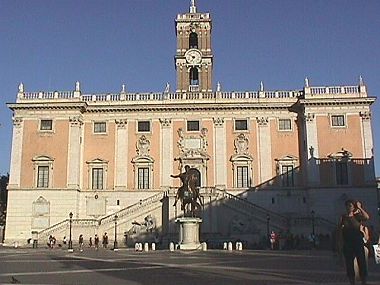 |
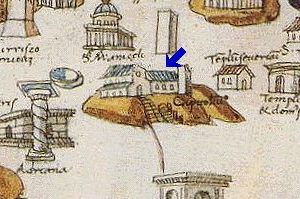 |
The social and religious importance of the Capitolium's
site kept growing, particularly during the Republican Age. A number of temples were
built here, among which the one dedicated to Jupiter, standing on the highest spot of the hill, was considered Rome's most sacred place of worship: among the several hundreds that were found in the ancient city, it acted as a cathedral.
The hill overlooks the area where the Roman Forum stood; in ancient times its top could be accessed from the same side, i.e. looking south (opposite to the present approach), which used to be less steep than now. |
During the Middle Ages, when the temples had crumbled and almost every trace of the ancient Roman
civilization had disappeared from this site, the Capitolium was nicknamed Monte Caprino
("goat hill"), after the custom of grazing goats and other animals all over the place.
The first important building to stand again here was Palazzo Senatorio
(Senators' Palace), first built in the 12th century over the remains of the
Tabularium, ancient Rome's state archive. The latter was located at one end of the Forum,
and had been meanwhile turned into a salt deposit, and then into a jail. |
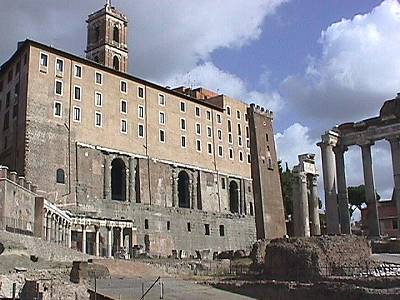 |
Of its six tall arches that look towards the Forum, only three are still open: pope Martin V had half of them filled up in the early 1400s, to prevent the outer wall from crumbling under the weight of Palazzo Senatorio.
The square began to achieve its present look during the 16th century, when Michelangelo was asked to draw a new plan for the site.
Capitolium Square around 1542-43, while the works were still in progress:

ü Palazzo Senatorio under reconstruction, lacking its new right half -
é the medieval tower was still in place -
ā the left half of the staircase was almost finished -
ä Palazzo dei Banderesi, altered during the second half of the century, and renamed P. dei Conservatori -
ģ the statue for the right half of the staircase, temporarily parked on one side of the square -
å the statue of Marcus Aurelius, which had been moved here from the Lateran -
ć on the left side of the square, the works for the making of Palazzo Nuovo were still a long way to come (1644)
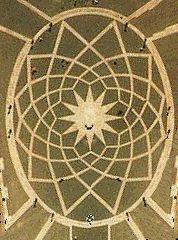 |
The present Palazzo Senatorio, built over the medieval one, is based on the famous artist's project, although after his death some changes were made while the works were still in progress by architects Giacomo Della Porta and Girolamo Rainaldi, who completed the building in 1605; the double staircase is the only original part entirely consistent with Michelangelo's original drawings.
He is also the author of the long flight of stairs leading to the square from below,
which climbs the northern side of the hill, opposite the Forum's area: during the Renaissance, the districts north of the Capitolium had become once again inhabited.
The famous artist had also drawn a geometric pattern for the square's pavement,
but this part of his project was set aside. Only during the early 1940s, i.e. four centuries later, Rome's Municipality retrieved Michelangelo's original plan, and finally paved the square with the famous oval pattern. |
Pope Paul III decided to decorate the newly refurbished site
with the famous bronze statue of emperor Marcus Aurelius, and - despite his choice displeased
Michelangelo - in 1538 he had it moved from the Lateran, where it originally stood,
and set in the center of the Capitolium Square, resting on a high stand (drawn by the famous
artist, as well).
The statue features the mounted emperor in the attitude of speaking to the people; Marcus Aurelius
is indeed remembered as one of Rome's most enlightened rulers. |
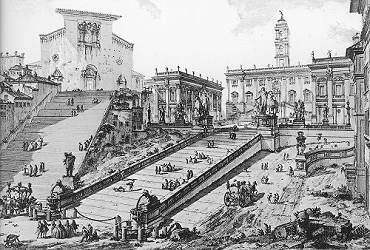 |
However, during the Middle Ages this statue was believed to represent Constantine the Great.
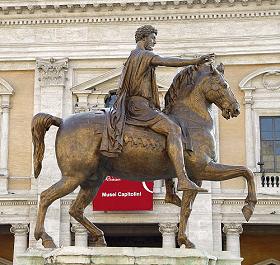 |
Since Constantine was the most celebrated emperor by the Church of Rome, having freed Christianity from its condition of underground religion, and being a Christian himself, this mistake enabled the bronze statue to remain well preserved in time.
Instead, after the rise of the new religion many other relics of the classic age, connected to pagan rites, suffered damages, or were let decay. |
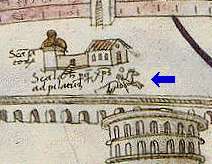 |
|
Originally, the statue was gilded. The golden layer came off in a short time (a part of it was
likely stolen); very soon, only a few patches of the precious metal were left in place.
But for a long time, the people believed that the statue had been originally made of gold, and that a bronze layer covered it, but was gradually coming off. This belief inspired a famous legend, according to which on the day the statue would have turned completely gold, the "owl" on the horse's head (a tuft of hair, mistaken for a bird), would have sung, and the city of Rome - thus the whole
world - would have come to an end.
Obviously, this never happened. But in recent times a dangerous threat to Marcus Aurelius
and his horse was caused by air pollution: in the late 1980s the original
statue (detail on the right) had to be carefully restored, given an indoor location, and replaced by a faithful copy, which now stands in the square. |
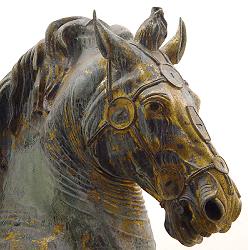 |
In modern times, the Palazzo Senatorio was chosen to be Rome's Town Hall, in acknowledgement of
the great importance that the Capitolium Hill had for the city in the past.
This square is also the site of the Capitoline Museums, which claim to be the most ancient public collection of antiquities in the world. They were opened around 1735, but the first specimens had been acquired much earlier, under pope Pius IV, in 1471.
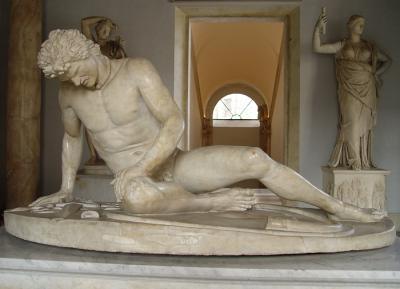
|
The Capitoline Museums are housed in the twin buildings that face each other on the two sides of the square. The one on the right (westwards) is Palazzo dei Conservatori, the see of the city's Curators, built by Giacomo Della Porta as of 1563, out of the preexisting mid 15th century Palazzo dei Banderesi. The one on the opposite side is Palazzo Nuovo (New Palace, begun in 1644), by Girolamo Rainaldi.
A modern underground passage, which is part of the museum, puts into connection the two buildings and the remains of the ancient Tabularium. |






